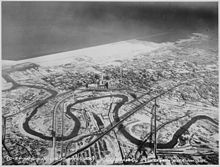Flats
When the Flats (German in about: the flat countries ) the flat, deep and highly industrially embossed valley is Cuyahoga in the city of Cleveland in US -Bundesstaat Ohio , respectively. It is around 800 meters wide, around 20 meters deep and extends from the mouth of the river into Lake Erie for several kilometers in a south-easterly direction inland and divides the city into two halves.
Cleveland's original settlement center was in the Flats; However, this was gradually abandoned due to the swampy terrain and rebuilt above the northeast embankment. The location on the lake, the development of the lower course of the river as a harbor basin and the construction of the railways through the valley promoted the rapid industrial development. From the second half of the 19th century, numerous blast furnaces , factories, mills, refineries and warehouses crowded along the Cuyahoga . The Flats grew into the largest and most important industrial area in the entire region.
Since the decline of heavy industry at the beginning of the 1980s, the flats have increasingly been idle . The largest remaining operation is the Mittal Steel steelworks about five kilometers inland. Other uses such as parks, stadiums, museums and apartments are increasingly establishing themselves in the inner city area.
Due to their topography, the flats hindered the city's development towards the southwest for a long time. The valley was overcome for the first time in 1878 with the construction of the Superior Viaduct . More bridges followed. Together with the old industrial plants, they shape the cityscape of Cleveland to this day.
source
- Encyclopedia of Cleveland History: FLATS. Case Western Reserve University, accessed September 19, 2009 .
Coordinates: 41 ° 29 ′ 31.2 " N , 81 ° 41 ′ 45.6" W.

